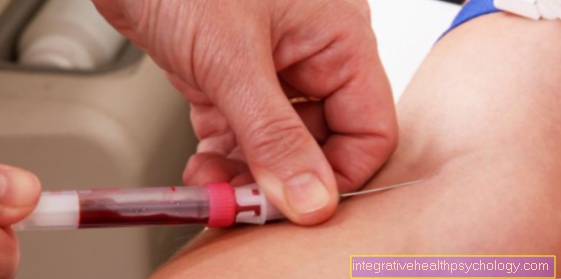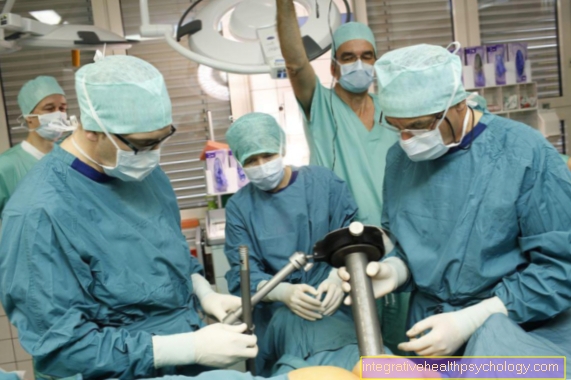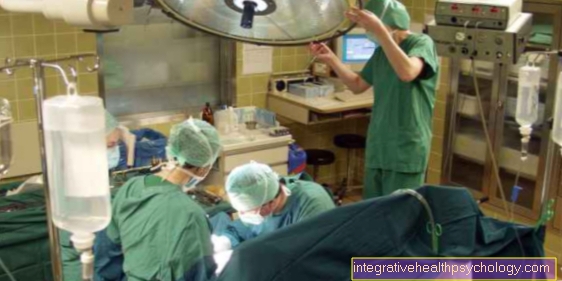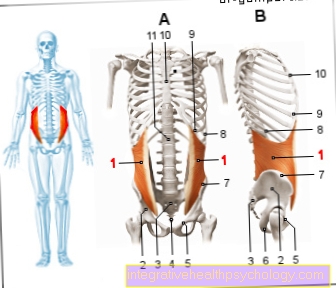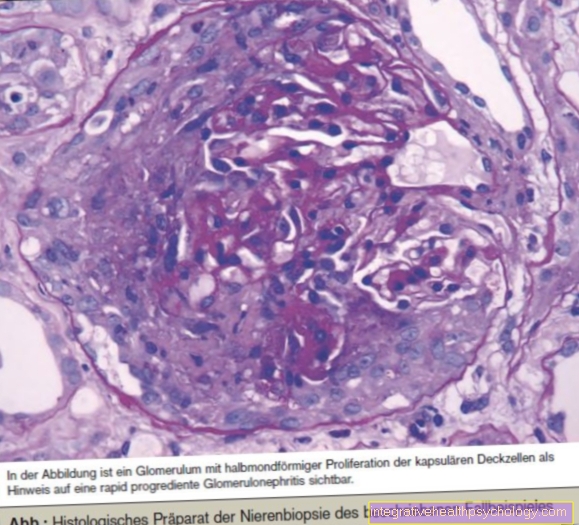Iliac crest
anatomy
The iliac bone (Os ilium) has several palpable bone points. One of these points is the iliac crest (syn .: iliac crest, or lat .: Iliac crest) as the upper limit of the iliac bone. It ends in the front Anterior superior iliac spine and in the back of the Posterior superior iliac spine. The iliac crests serve to stabilize the pelvic ring.
Furthermore, due to its superficial position, the iliac crest is ideal for bone marrow removal.
The area under the iliac crest is also called the iliac scoop (Ala ossis ilii) called. The iliac bone is an important starting point for muscles and therefore has three ridges to increase surface area: Labium internum and Labium externum (lat. "labia": Lip,"internum": Inside, "externum“: Outside) as well as the Linea intermedia (lat. "Linea": Line,"intermedium":" Middle ").
Read more on this topic: Pelvic bones
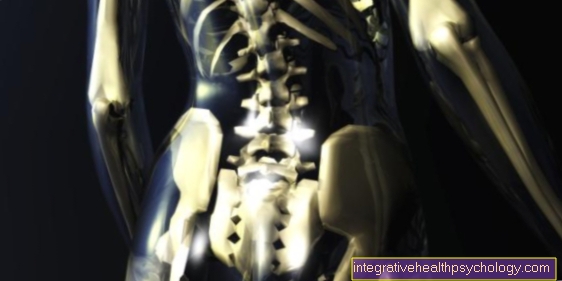
function
The iliac crest is instrumental in the Stabilization of the hip joint involved. Various ligaments attach to the various parts of the iliac crest.
On the back third of the Iliac crest connects that Iliolumbar ligament the iliac crest with the fourth and fifth lumbar vertebrae. This connection reduces the freedom of movement of the Sacroiliac joint (Articulatio sacroiliaca), but it prevents both pelvic blades from moving away from each other. In addition, the pressure and load transfer to the joint is improved.
The Sacrotuberous ligament serves to stabilize the rear Sacroiliac joint in which it is the Posterior superior iliac spine, the sacrum (Sacrum) and the ischial tuberosities (Sciatic tuberosity) connects. This strong connection prevents the sacrum from tilting backwards.
Between the Anterior superior iliac spine and the pubic bone (Pubic tuberosity) it runs Inguinal ligament (Vesalius band or Inguinal ligament). The inguinal ligament represents the lower and front boundaries of the inguinal canal (Canalis inguinalis) represent.
Apart from that, the iliac crest is a important point of origin and attachment of various muscles.
Muscle insertion
The iliac crest has several attachment points for muscles: The crest itself with its three ridges (Labium internum, Linea intermedia and Labium externum) as well as the front and rear comb tips (Anterior superior iliac spine and Posterior superior iliac spine).
At the Labium externum of the Iliac crest sets the M. obliquus externus abdominis on. Analogously, the M. obliquus internus abdominis at the Labium internum as well as at the Linea intermedia on. Of the Transversus abdominis muscle also sets on the Linea intermedia of the Iliac crest on. The Anterior superior iliac spine serves as the origin of the M. tensor fascia lataewhich occurs during internal rotation and flexion of the thigh (Femur) becomes active. This muscle is often more pronounced in sprinters. Of the M. sartorius (Tailor's Muscle) also has that Anterior superior iliac spine as the origin. Of the Gluteus maximus muscle (gluteus muscle) is the main hip extensor and is at the Posterior superior iliac spine attached.
Iliac crest pain

Pain in the iliac crest can have various causes. In the event of a fall or trauma, there is a possibility that the pelvic bone or the iliac crest will be bruised or even torn. In such cases, severe pain occurs, especially when walking. A doctor should be consulted for diagnosis. An X-ray should then be taken to confirm the diagnosis.
Read more on this topic: bruise
Another possible cause of pain in the area of the iliac crest is the abdominal muscle strain. This is an overstretching of the Sarcomeres, i.e. the smallest functional units of a muscle, the abdominal muscles (M. obliquus internus abdominis, M. transversus abdominis, M. obliquus externus abdominis). Muscle strains are usually the result of muscle overload caused by inadequate (incorrect or excessive) movements or a lack of or insufficient pre-stretching. Such injuries often occur in connection with sports such as soccer or during more intense running or sprinting units. The pain is often localized in the iliac crest area and can radiate to the navel. If you suspect that you have pulled abdominal muscles, you should see a doctor. In addition to a physical exam, imaging (magnetic resonance imaging) can also be useful.
Read more on this topic: Abdominal muscle strain
Physiotherapy should be used as a supplement to adequate pain medication.
Read more on this topic: Pelvic pain
Bone marrow puncture
A bone marrow puncture can be used for both diagnostic (sampling) and therapeutic (obtaining stem cells from stem cell transplantation) purposes. A bone marrow puncture is, for example, if anemia is suspected (anemia), Blood cancer (leukemia) or bone marrow metastases in the context of cancer.
The bone marrow collection is carried out after a detailed explanation at the iliac crest under local or general anesthesia. The bone marrow donor can either lie on its stomach or on its side, depending on the indication. The puncture is done with a needle and usually only small incisions are necessary. The aspirated bone marrow is then either examined with a microscope or used for stem cell transplantation. The maximum amount that can be withdrawn is defined by the patient's weight. The cells of the bone marrow regenerate within a few weeks. A compression bandage is applied to prevent bleeding. After the procedure, you should remain under medical observation for at least an hour and then take it easy. Dangers of a bone marrow removal are infections of the puncture site or an inflammation of the bone marrow and the periosteum or the neighboring tissue. After the procedure, pain similar to muscle soreness can occur. In extreme exceptions, the iliac crest can break.
Iliac crest fracture
Fractures in the area of the iliac crest are very rare. these can as a result of a traumatic event (for example a traffic accident) or through pathological bone loss processes (osteoporosis) arise.
The bone fracture is symptomatic Painthat special during exercise or movement occur and can shine up to the navel. Lying on the injured side also causes pain, which can lead to sleep disorders. In the area of the iliac crest one can also bruise (Hematoma) or one swelling to be watched. If a hernia is suspected, a doctor should be consulted. Using an ultrasound (Sonography) or imaging (X-ray or computed tomography), the diagnosis can be confirmed.
Depending on the degree of injury, the break will be conservative (Bed rest) or operational (Stabilization by plates) treated. A Pain medication should be considered if the patient has severe complaints. In the event of an operation or bleeding, should blood-thinning drugs (ASS, Coumarin derivatives…) be avoided.





